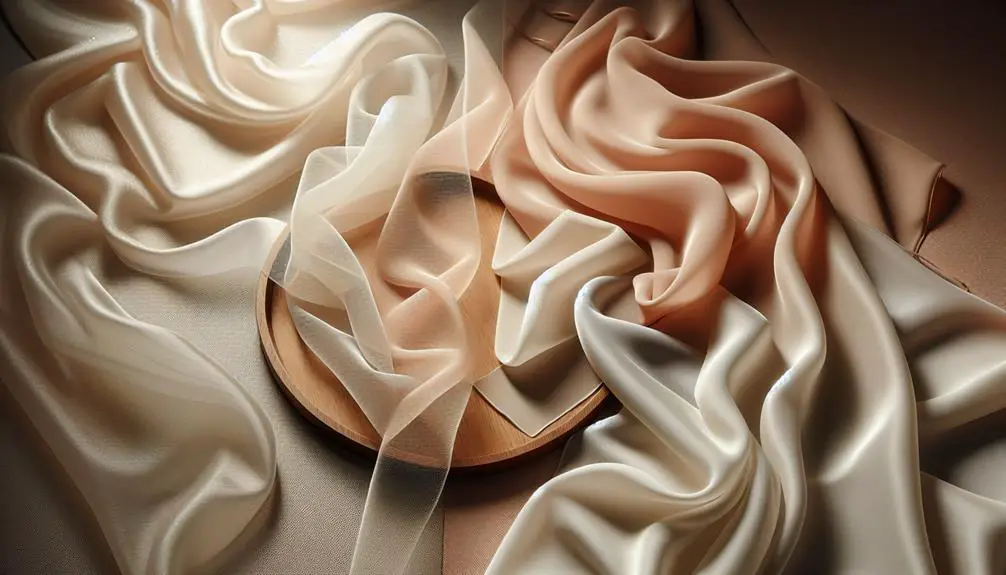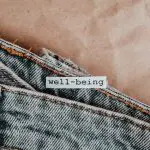So, you're wondering if chiffon is a type of silk, right? Well, I've got the scoop for you! Chiffon is actually a lightweight, sheer fabric, which can be made from silk. Traditionally, it started off as silk, giving it that luxurious, elite vibe. However, these days you can also find chiffon made from synthetic materials like polyester, which is way more affordable. Silk chiffon has a natural sheen and feels super smooth against the skin, making it perfect for fancy clothes. There's a lot more to chiffon's story and its different uses that might surprise you.
Table of Contents
Key Takeaways
- Chiffon is a lightweight, sheer fabric, not specifically a type of silk.
- Chiffon can be made from silk or synthetic materials like polyester.
- Silk chiffon is a variant made exclusively from silk, offering a luxurious sheen and feel.
- Synthetic chiffon provides durability and is often more affordable than silk chiffon.
- Both silk and synthetic chiffon share similar textural qualities and uses, but differ in material composition.
Understanding Chiffon Fabric
Chiffon is a lightweight, sheer fabric that's often made from silk or synthetic materials like polyester. You might've seen it used in scarves, blouses, and evening dresses. It's got this unique, slightly rough texture which is a result of the twist in the yarns. They twist these yarns super tight, and that's what gives chiffon its slight puckering. It looks kind of like it's shivering! This texture also makes chiffon a bit more durable than you'd expect from such a delicate-looking material.
Now, because it's so light and airy, chiffon is a dream for draping. It falls softly and contours the body in a way that's just, well, flattering. Handling chiffon can be a bit tricky though. It's so slippery and delicate, cutting and sewing it requires a bit of patience and a gentle hand. You can't just rush through it.
Also, chiffon's sheerness means it's often layered or used with a lining to make sure it isn't too revealing. Whether it's silk or a synthetic like polyester, chiffon brings a touch of elegance and flowiness to any outfit.
The History of Chiffon
Delving into its history, chiffon has evolved from a luxurious silk exclusive to a versatile fabric accessible in today's fashion world. It's fascinating how this fabric has woven its way through time. Originally made purely from silk, chiffon was the go-to material for the elite. The name itself, derived from the French word for 'cloth', hints at its prestigious beginnings.
As the years rolled on, innovations in textile manufacturing introduced synthetic fibers, which dramatically altered chiffon's accessibility and uses. However, the traditional silk chiffon still holds a special place in high fashion due to its superior quality and feel.
Here's a quick table to help you visualize the journey of chiffon through time:
| Era | Material Used | Significance |
|---|---|---|
| Early 20th C | Silk | Luxury item for the elite |
| 1930s | Silk | Hollywood glamor, evening wear |
| Post-WWII | Silk, Nylon | Introduction of synthetic versions |
| 1970s | Mixed fibers | Disco era popularity |
| Modern Times | Varied | Widespread use in diverse fashion |
Silk Vs. Synthetic Chiffon
When comparing silk and synthetic chiffon, it's clear that each type brings its own set of benefits and drawbacks. Silk chiffon, derived from natural silk fibers, is renowned for its superior softness and natural sheen. It drapes beautifully, making it a favorite for elegant dresses and scarves. However, it can be quite pricey and demands gentle care, typically requiring dry cleaning to maintain its texture and color.
On the flip side, synthetic chiffon, often made from polyester, presents a more affordable and durable option. This type of chiffon is easier to care for, often being machine washable and less prone to wrinkles compared to its silk counterpart. Here's a quick rundown to illustrate these differences:
- Touch and Feel: Silk chiffon feels luxuriously smooth, whereas synthetic chiffon is slightly coarser.
- Care: Silk needs dry cleaning; synthetics often just need a simple machine wash.
- Durability: Synthetic chiffon holds up better in regular use, resisting snags and tears.
- Cost: Silk chiffon generally costs more due to its natural origins and complex production.
Choosing between silk and synthetic chiffon really depends on your needs, budget, and how you plan to use the fabric. Each has its place in the world of textiles, catering to different preferences and requirements.
Properties of Silk Chiffon
Silk chiffon boasts a unique combination of softness, lightness, and sheer texture that makes it stand out in the world of fabrics. Let's dive deeper into what exactly sets silk chiffon apart from other materials.
First off, silk chiffon is incredibly lightweight. This isn't just about being easy to carry around; it means it drapes beautifully over any shape, flowing gracefully with every movement. That's a big deal if you're into fashion or sewing, as it allows for elegant garments that don't feel heavy.
Then, there's the softness. Silk chiffon feels like a whisper against the skin. This isn't just comfy—it's luxurious. Handling silk chiffon, you'll notice how it seems to glide through your fingers, a property that makes it a favorite for delicate sewing projects.
Now, let's talk about its sheer texture. This sheerness isn't just for looks; it plays a practical role too. It allows for layering without adding bulk, giving creators the ability to build depth in designs or simply play with color and light in outfits.
Common Uses of Chiffon
Now that we've talked about what makes silk chiffon special, let's look at how people use it.
You'll find chiffon in all sorts of clothing, from elegant dresses to flowy scarves.
It's also a popular choice for decorations like drapes and table runners because of its light, airy feel.
Chiffon Clothing Items
Chiffon is super versatile, often used for making airy blouses, elegant evening wear, and flowy dresses. Here's how you'll typically see chiffon transforming into stunning outfits:
- Wedding Dresses: Imagine a bride in a chiffon gown, layers cascading down, catching every light with a subtle sheen, perfect for a dreamy wedding.
- Scarves: Lightweight chiffon scarves add a pop of color and elegance to any outfit, swirling lightly with the breeze.
- Sarees: In South Asian fashion, chiffon sarees are a favorite for their graceful drape and soft texture, making them ideal for festive occasions.
- Summer Skirts: Chiffon skirts are a go-to for beach outings or summer picnics, as they're light and keep you cool while offering a playful, flirty vibe.
Chiffon in Decorations
Beyond clothing, I often see this fabric used in home decor for a touch of elegance and softness. Chiffon's lightweight and slightly sheer qualities make it perfect for creating airy and attractive curtains that don't block out the light completely but provide a gentle filter.
It's also popular for throwing over lampshades, softening the harshness of electric light, and adding a cozy, inviting glow to any room. At events like weddings, chiffon can transform spaces dramatically. Draped across ceilings or around chairs, it adds a graceful, flowing element.
Even in small doses, like table runners or centerpiece wraps, chiffon brings a level of sophistication and detail that really enhances the overall aesthetic of any setting.
Crafting With Chiffon
Working with chiffon can be tricky due to its delicate nature. As someone who's dabbled in creating clothing and accessories, I've found a few tricks that make handling this fabric a bit easier.
When you're set to craft with chiffon, visualizing your steps helps a ton. Here's how I usually go about it:
- Layout Preparation: I clear a large, flat surface and carefully spread out the chiffon. This prevents unwanted wrinkles and ensures precise cuts.
- Cutting Technique: Using sharp, fine-pointed scissors is key. I make sure my cuts are clean and deliberate to avoid fraying edges.
- Sewing Settings: I adjust my sewing machine to a fine, straight stitch and use a new, sharp needle. This is crucial to prevent snagging the fabric.
- Handling Edges: To finish the edges neatly, I often use a narrow rolled hem or hand stitch with a fine thread. This adds durability and a touch of elegance.
Each step requires patience and precision, but mastering these can really elevate your crafting game. Whether you're making a flowy summer dress or a delicate scarf, these tips ensure your chiffon piece turns out beautifully. Remember, it's all about gentle handling and enjoying the process!
Caring for Chiffon Fabrics
After crafting with chiffon, it's just as important to know how to keep it looking its best. Caring for this delicate fabric isn't as daunting as it might seem, but there are a few key steps you shouldn't skip.
First off, always check the care label before you do anything. This little tag is your best friend when it comes to keeping your chiffon in top shape. Generally, it's safest to hand wash chiffon with a mild detergent. If you're dealing with silk chiffon, cold water is a must to prevent shrinkage and maintain the fabric's integrity.
When drying chiffon, steer clear of wringing it out. That can seriously damage the fibers. Instead, lay it flat on a towel and roll it up gently to remove excess water. Then, lay it flat to dry completely. This method helps preserve the fabric's shape and texture.
Ironing chiffon can be tricky. Always use a low heat setting and consider placing a cloth between the iron and the fabric to act as a buffer. This prevents heat damage and keeps your chiffon looking smooth and wrinkle-free.
Comparing Costs: Silk and Polyester
When comparing silk and polyester chiffon, the cost differences are pretty significant. Let's dive into why that's the case and what it means for you if you're thinking about buying or using chiffon.
- Production Costs: Silk is a natural protein fiber, produced by silkworms. This process is labor-intensive and costly. Polyester, on the other hand, is a synthetic fiber, made from petroleum products through a chemical process that's far cheaper and faster.
- Supply and Demand: Silk is less abundant than polyester. It's considered a luxury material and is less available on a global scale, which drives up its price. Polyester is widely available and produced in massive quantities, keeping its price low.
- Durability and Maintenance: Silk chiffon is delicate and requires careful handling and dry cleaning, which adds to its overall cost. Polyester is more durable and can usually be machine washed, leading to lower maintenance costs.
- Market Positioning: Silk chiffon is often marketed as a premium product, which allows sellers to charge more. Polyester chiffon is typically targeted at budget-conscious consumers, reflecting in its lower price.
Understanding these factors helps in making an informed choice based on your budget and the value you place on fabric quality.
Environmental Impact of Chiffon Production
Let's delve into the environmental impact of producing chiffon, whether it's made from silk or polyester.
If we're talking silk chiffon, the biggest issue is the silk production itself. Silk worms are fed on mulberry leaves, which requires extensive land use and water consumption. Plus, the process of extracting silk from the cocoons isn't exactly gentle on the environment due to the energy used and emissions released.
Now, if we switch gears to polyester chiffon, the story changes but not necessarily for the better. Polyester is a synthetic material derived from petroleum, a non-renewable resource. The production of polyester fabric involves large amounts of water and energy, and it releases significant pollutants, including greenhouse gases. Moreover, this type of chiffon doesn't break down easily, adding to the problem of long-term waste in our landfills.
Both materials, while beautiful and useful, carry hefty environmental costs. It's essential to consider these impacts when choosing materials for fashion production. Being aware of the ecological footprint can guide us towards more sustainable practices, such as using recycled polyester or supporting silk producers who invest in less harmful production technologies.
Choosing the Right Chiffon
When it comes to choosing the right chiffon, there are a few key things you need to consider.
First, you'll want to understand the different types of chiffon fabric available—each has its own feel and suitability for various projects.
Next, I'll give you some handy tips on how to care for chiffon to keep it looking great, and we'll also look at the best uses for this versatile fabric.
Chiffon Fabric Types
Choosing the right type of chiffon for your project depends on understanding its various forms, from silk to synthetic. Here's a quick rundown to help you out:
- Silk Chiffon: Luxurious and lightweight, perfect for elegant evening wear. It's sheer and has a slight shimmer, giving it a rich vibe.
- Polyester Chiffon: More affordable and durable than silk. Ideal for everyday outfits since it's easier to handle and maintain.
- Rayon Chiffon: Offers a nice drape similar to silk but at a lower cost. It's breathable, making it great for summer dresses.
- Nylon Chiffon: Strong and generally used in multi-layered dresses. It resists shrinking and stretching.
Each type has its unique benefits, so think about what you need from the fabric before making a choice.
Chiffon Care Tips
Caring for chiffon requires understanding the specific needs of each type, whether it's silk, polyester, rayon, or nylon. Choosing the right type of chiffon isn't just about the look; it's about how you'll manage its care long-term. Here's a quick guide to help you get a grip on what each type demands:
| Material | Wash Method | Ironing Temp |
|---|---|---|
| Silk | Hand wash | Low |
| Polyester | Machine wash | Medium |
| Rayon | Hand wash | Low |
| Nylon | Machine wash | Low |
Ideal Chiffon Uses
Selecting the ideal chiffon for your project depends on how you plan to use it. Here's a quick guide to help you choose:
- Evening Wear: Choose silk chiffon. It's elegant and flows beautifully, perfect for those dreamy dresses.
- Summer Scarves: Opt for a cotton blend. It's light and airy, making it ideal for staying cool while looking chic.
- Curtains: Polyester chiffon is your go-to. It offers a sheer, graceful drape but is more durable and easier to care for.
- Craft Projects: Any chiffon scraps will do. They're great for making accessories like hair bands or adding decorative touches to other fabric projects.
Innovations in Chiffon Fabrication
Recent advancements in chiffon fabrication have introduced more durable and eco-friendly options to the market. I've learned that manufacturers are now focusing on reducing the environmental impact of chiffon production. For example, they're using recycled materials to create new chiffon fabrics. This not only reduces waste but also saves energy and resources.
They're also improving the dyeing process to make it less harmful. Traditional dyeing often uses a lot of water and chemicals, which isn't great for our planet. Now, some companies are turning to natural dyes or more efficient methods that use less water and produce fewer pollutants.
Another cool thing I've found out is the development of biodegradable chiffon. Instead of sitting in a landfill for years, these fabrics can break down naturally once they're no longer needed. It's a big step forward in making fashion more sustainable.
Lastly, the strength and resilience of chiffon are getting a boost. New weaving techniques are making the fabric tougher, so it can handle more wear and tear without losing its delicate appearance. This means your chiffon outfits might last longer and look better over time, which is awesome for both your wardrobe and your wallet.
Frequently Asked Questions
Can Chiffon Fabric Be Dyed at Home?
Yes, I've successfully dyed chiffon at home before. It's like turning a blank canvas into a vibrant masterpiece, but you'll need the right type of dye and a gentle hand to avoid damage.
Is Chiffon Suitable for Winter Clothing?
I wouldn't recommend chiffon for winter clothing because it's lightweight and doesn't offer much warmth. It's better suited for spring or summer outfits where breathability and lightness are more desirable.
How Is Chiffon Perceived in High Fashion?
In high fashion, chiffon's like a whisper of elegance—light and ethereal. I've noticed it's often used in flowing dresses and scarves, adding a touch of class without overwhelming the wearer's personality.
Are There Any Famous Designers Known for Using Chiffon?
Absolutely, many famous designers like Chanel and Dior have showcased chiffon in their collections. It's popular for its elegant, flowing properties, making it a staple in luxury fashion for gowns and dresses.
What Are the Fire-Resistant Properties of Chiffon?
Chiffon isn't fire-resistant; it's actually quite flammable. I'd recommend treating it with fire-retardant chemicals if you're concerned about safety, especially for curtains or other home decor items made from this material.
- How Does Ring Spun Cotton Affect Garment Fit and Shape Retention? - August 13, 2024
- What Are the Challenges in Producing Ring Spun Cotton? - August 13, 2024
- Is Ring Spun Cotton Suitable for Plus-Size Clothing? - August 13, 2024







